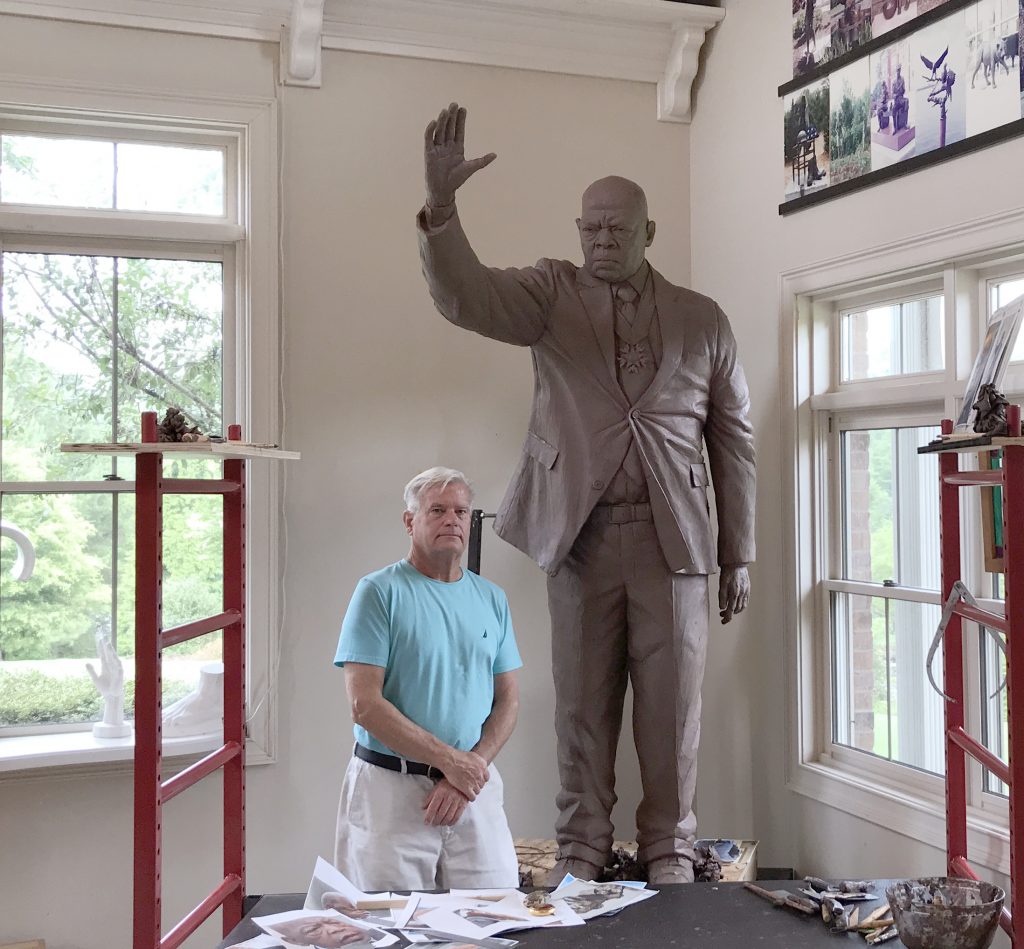
Gregory Johnson ’77, M.A. ’80, in his Cumming, Georgia, art studio with his statue of civil rights icon John Lewis for an Atlanta park honoring Georgia leadership that has shaped the world.
On March 7, 1965, a 25-year-old Black man born in Atlanta walked down the left side of the Edmund Pettus Bridge in Selma, Alabama, his hands stuffed in his jacket pockets as he stared down the road leading east toward Montgomery.
John Lewis, the civil rights icon who died on July 17 at the age of 80, was leading a large contingent of people intending to march to Alabama’s capitol city demanding voting rights when state troopers stopped them just off the foot of the bridge and inhumanely beat them with billy clubs while filling the air with tear gas and pepper spray. Lewis, who would later serve Georgia in Congress, never stopped fighting for equal rights and was a champion of nonviolent movements.
In 1965, Gregory Johnson ’77, M.A. ’80 was somewhere in Illinois just beginning to scratch the surface of his art career. Living so far north, he never had a lot of exposure to John Lewis or the Jim Crow South. Now, all of the artist’s focus is seemingly on the late Congressman.
Johnson was selected to create Lewis’ statue that will reside in Atlanta’s Rodney Mims Cook Sr. Park, land dedicated to Georgia leadership that has shaped the world.
A renowned sculptor whose work has been showcased around the world, Johnson spent more than 500 hours creating a 7-foot, 800-pound bronze statue that millions of eyes will see in the park just west of downtown Atlanta. It will be the second of 18 statues in the park honoring Georgia peacekeepers, including Martin Luther King Jr., Andrew Young, and Tomochichi, a Native American who helped the colonists lay out roads, including the one to Savannah.
“Sculptures can offer healing. They can offer inspiration, and they can be educational,” Johnson said. “I think what it’s going to capture is (Lewis’) philosophy of civil rights; that if you believe all men are created equal, then they should be treated equal.”
With hundreds of Lewis photos by his side, Johnson went to work in his Cumming, Georgia, studio. He studied the Congressman’s life of activism and service and narrowed down his design.
He chose to keep both of his subject’s feet on the ground, firmly planted, signifying that he was here to stay. The straight lines Johnson put on Lewis represented the serious side, laying the foundation. The curved lines were supposed to be happy and lyrical, signifying Lewis’ outgoing personality. Johnson also put the presidential medal of freedom—which President Barack Obama awarded him in 2011—around his neck.
“I wanted to capture the man’s soul,” Johnson said. “He’s stern, harsh, determined, and yet there’s still that soft side of him.”
That attention to detail on previous works is precisely why Rodney Mims Cook Jr., president of the National Monuments Foundation, chose Johnson for the project. The son of former Rep. Rodney Mims Cook Sr., whom the Atlanta park is named after, had seen some of Johnson’s work and was particularly drawn to a statue he did of George Washington. He knew Johnson was the sculptor for the job.
“I think what it’s going to capture is (Lewis’) philosophy of civil rights; that if you believe all men are created equal, then they should be treated equal.”—Gregory Johnson
“He’s among the best I’ve ever seen,” Cook said of the dual Illinois State alum.
The late Congressman won’t get to see the unveiling of the statue, which is scheduled to take place later this month. Johnson, unfortunately, never met him. But Lewis did get to see a photo of Johnson’s progress and commended the artist to Cook.
“(Lewis) said ‘you know Rodney, I feel like I’m looking in the mirror when I’m looking at this picture,’” Cook said.
Johnson climbed plenty of ladders to get to such a position and credits a well-rounded Illinois State education for putting him on a path to success. He especially remembers an art history course with the late Dr. Harold Gregor.
He left Illinois State as a painter and had stints print making, casting bronze, sculpting statues, and creating modern art. Other recent humanity projects have been recognized. His statue of Eugene Bullard, the world’s first Black fighter pilot, was recently installed at the U.S. Air Force Museum of Aviation in Warner Robins, Georgia. His World War II Legacy of Humanity bronze sculpture was installed on the Forsyth County Courthouse Square in Cumming.
Throughout his career, Johnson adapted with the ever-changing market. He was driven to tell stories through art, even when the going got tough. He encourages future artists to keep working at their craft and move through roadblocks, just as Lewis did throughout his life.
“What I’d like to tell all the artists is that yes, it is a long, hard and winding road, and lots of times along that path you want to quit,” Johnson said. “But if you keep making yourself move forward in a positive way, you will make it.”
Both the artist and sculptor subject are examples of when the going gets tough, the tough get going.
Apply now for fall 2021.

